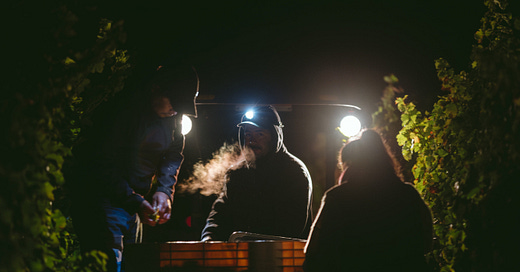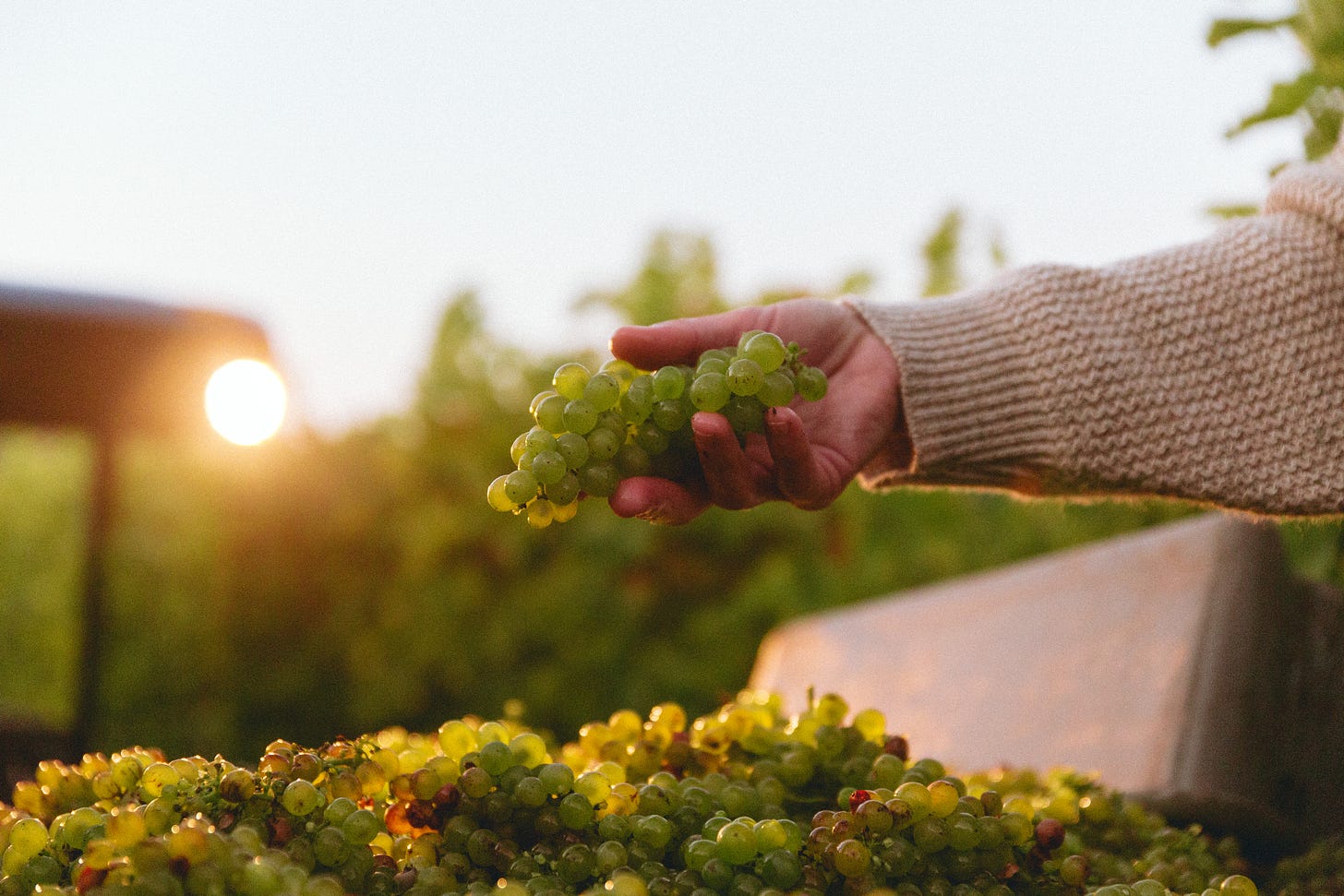Marketing Wine Feels Like An Uphill Battle Right Now
Wineries are closing, younger consumers aren’t buying, and the industry is struggling. But I'll be damned if I give up on it.
Wine can feel like an impossible industry to be in sometimes.
Wineries are skipping vintages or even closing outright. Boomers—the historic backbone of wine purchases—are aging out, Millennials are too broke to buy good wine, and Gen Z aren’t (yet) in their fine wine era. Tariffs are hitting us hard, the U.S. surgeon general is putting wine in the same category as cigarettes, and health and wellness influencers are demonizing it for containing alcohol at all (or, inexplicably, saying that European wines are “healthier” than U.S.-made wines—what?)
In short, there’s too much inventory and not enough buyers. It’s enough to make anyone working in wine want to stress heave.
Esther Mobley of the SF Chronicle recently published an article titled “This Will Be the Year of California Winery Closures,” and to be honest, it left me feeling pretty hopeless. The article reports that, for the first time in a generation, the number of wineries in the U.S. has declined, and it’s only expected to get worse. Wineries are shutting down, brands are folding, and even major players like Constellation Brands are rumored to be looking for a way out of the wine business altogether.
It’s a stark reality.
And yet, I constantly remind myself that most of us didn’t get into this industry to get rich—after all, there’s that old joke: If you want to make a million dollars in wine, you need to start with two million.
Because for most of us, it was never just about the money. We got into wine because we love the craft, the land, the stories, the community. Wine is art and passion… it’s a god damned way of life—which sounds so cheesy, I know… But that’s exactly why it’s so hard to watch this industry struggle.
I was reminded of this at the Women Winemakers & Culinarians Celebration this month. There was a comedy show during the event, and both comedians made jokes about how everyone in the room must be rich. And yet, the irony was that the vast majority of us there aren’t wealthy—at least not in the financial sense. In fact, the entire purpose of that weekend’s celebration was to uplift a traditionally overlooked and struggling subset of the wine industry: women.
It was a perfect example of the common misconceptions people have about this business. From the outside, wine seems glamorous. People assume that everyone who owns a winery or works in wine must be rolling in the dough. But the reality is that most of us are just doing our best. We do it because we love it, not because it’s easy or calculated to make us loads of money.
So, as hard as things may feel right now, I believe we must find ways to adapt and keep moving forward because I’ll be damned if I have to abandon what I love.
Yes, I’ve Said All of This Before—And I’ll Say It Again
I know that a lot of the advice I’m about to share isn’t new. If you’ve been reading the Wine Marketing Field Guide for a while, you’ve heard me talk about many of these strategies before. But if there’s one thing we marketers know well, it’s that people need to see something multiple times before they actually take action.
So maybe this is the nudge you needed. Maybe it’s the reminder that this isn’t just about surviving—it’s about thriving in a shifting industry. Maybe this time, you’ll decide to actually implement one of these strategies instead of just thinking about it.
Because the wineries that survive this shift will be the ones that actually do something about the changes that are coming.
1. Don’t Overlook Gen X—They’re Buying Wine Now
For years, the wine industry has blamed Millennials and Gen Z for not buying enough wine, but let’s remember that half of Gen Z aren’t even of legal drinking age yet, and the other half are just coming out of college and struggling to start careers in an impossible economy. You weren’t spending $50 on pinot noir at 21, either!
Many Millennials are growing their families and so aren’t allocating much of their budget to luxury products like wine. Those who do have disposable income often prioritize travel, dining experiences, or wellness-focused spending over stocking their home with cases of wine. Plus, this generation came of age during the rise of craft beer, spirits, and RTDs, meaning wine has had to compete for their attention in a way it never did with previous generations. They’ll buy a wine for a special occasion, but they likely aren’t buying wine to age or for weekday enjoyment.
And while I think it’s important to think about the future and find ways to market to the youths, there’s a whole generation right now that’s financially stable, actively purchasing wine, and not getting nearly enough attention: Gen X.
Gen X (currently in their late 40s to mid-50s) has the disposable income and the drinking habits that make them an ideal audience for wineries. Unlike younger generations who are just starting to explore wine—Gen X is already invested. Many of them have been buying wine for years, they value quality over trend-hopping, and most importantly, they’re willing to spend money on wines they love.
So instead of putting all the focus on “How do we get Millennials and Gen Z to drink more wine?” let’s also ask:
Are we doing enough to market to Gen X, a group that’s ready to buy right now?
That means:
Speaking directly to them. Gen X isn’t looking for the same flashy, ultra-short content that appeals to Gen Z. They appreciate well-crafted storytelling, deeper wine education, and marketing that respects their knowledge.
Making it easy for them to engage. Many in this generation still prefer email newsletters over social media, enjoy in-person tasting experiences, and appreciate well-designed loyalty programs and wine clubs.
Recognizing their purchasing power. Gen X is at a prime point in their lives to invest in high-quality wine. They are not the generation searching for the cheapest bottle (or even the second cheapest wine 😂)—they’re ready and willing to pay for interesting wines at higher price points.
Yes, we should continue thinking about the future of wine with younger consumers. But ignoring Gen X in favor of chasing younger audiences who may not yet have the purchasing power is leaving money on the table, you silly goose.
2. Rethink the Tasting Room Experience
A huge part of wine sales has always been driven by in-person experiences, but the traditional tasting room model may not be enough anymore.
Things we can offer:
Unique offerings like blind tastings, food pairings, vineyard hikes, or hands-on winemaking activities.
A more relaxed, social atmosphere. Wine gardens (same vibes as a beer garden, but you know… wine), lounge-style seating (but I beg you to go easy on the adirondaks, they’re quite undignified to get out of), or events that encourage interaction rather than just sipping and leaving.
Making it Instagrammable. Like it or not, people want to share their experiences. Set up spaces that make them want to take a photo and tag your winery.
The tasting room can still be a major driver of direct-to-consumer sales—if we rethink how we’re using it.
3. Educate Without Intimidating
For many people, wine still feels really fucking complicated. They’re afraid to order the wrong thing at a restaurant. They don’t know how to describe what they like. And instead of guiding them, the wine industry often makes them feel stupid for not knowing, which is super icky behavior, let’s be real.
Use social media to educate in a fun, approachable way. Create short, engaging videos that answer common questions—I like Carhartt Family Winery’s “That’s Not a Dumb Question” Series. Show people how to taste wine without making it pretentious.
Offer guided, confidence-boosting experiences. Think “Wine for Newbs” tastings or cheat-sheet style menus that help people learn as they drink.
Make it easy to buy. Suggest pairings, create mix-and-match packs, and guide people toward what they’ll love instead of making them feel like they need to know everything before they buy.
Making wine approachable is one of the easiest ways to turn hesitant consumers into loyal ones.
Side note: Marie Cheslik of Slik Wines is writing a book, possibly titled “How to Read a Wine Label,” which is genuinely such a great idea and if you don’t stock it in your shop when it’s published, you’re doing your fans a huge disservice.
4. Build a Community
As we’ve established, wine is a way of life, my dudes. One of the main points of being human, according to Maslow’s Hierarchy of Needs, is to be a part of a community. So… do that.
Be a brand they want to be part of. Show up authentically online, in person, and through your marketing. Share real stories about your team, your vineyard, and what makes your wine special. Everyone can make good wine—what sets you apart are your people.
Engage directly with your audience. Reply to comments, send DMs, offer behind-the-scenes content, and make your customers feel like they matter. In a future post, we are going to talk about the golden rule, but the gist of it is to give as much engagement as you hope to get.
Encourage user-generated content. Ask your customers to share photos of their favorite wine moments and re-share them. The more they see others enjoying your wine, the more they’ll want to be part of it. This is one of the reason the “Tagged” tab on Instagram is SO fucking important and should be curated and encouraged accordingly.
5. Speak Up for the Industry
Wine is under attack from multiple angles right now—whether it’s government regulations, health misinformation, or outdated policies that make it harder to sell directly to consumers.
Get involved with advocacy groups. Support organizations that are fighting for fair wine laws and regulations. Free the Grapes, the folks who put on DTC Symposium every year, is one such group.
Educate consumers about responsible drinking. Wine isn’t the same as hard liquor, and we need to be part of the conversation about how it fits into a balanced lifestyle. Moderation and community, we love to see it.
Push for better direct-to-consumer policies. The fewer barriers there are to shipping and selling wine, the better the industry will be. Again, see the work that Free the Grapes is doing.
If we don’t fight for wine, no one else will.
The tl;dr: Hope is Not Lost
Yes, the wine industry is facing major challenges. But that doesn’t mean it’s doomed.
The wineries that survive (and thrive) will be the ones that are willing to evolve.
If you take away one thing from this article, let it be this:
Change and adaptation are necessary and the future of wine depends on what we do next.
So, what’s one thing you’re going to change this year? Let’s talk in the comments.







Yes, 100%, no 1000% agree. It's too soon to throw in the towel. Not even close. Your suggestions are spot on. This past month I co-hosted a pop-up wine bar for 28 days in the center of Paris -- we rented a coffee shop which closes at 4pm and were open 7/7. It was a big success, particularly with Gen X. We wrote up a summary about what worked and what we learned here https://kapitelzweiwine.substack.com/p/what-we-learned-after-hosting-a-pop